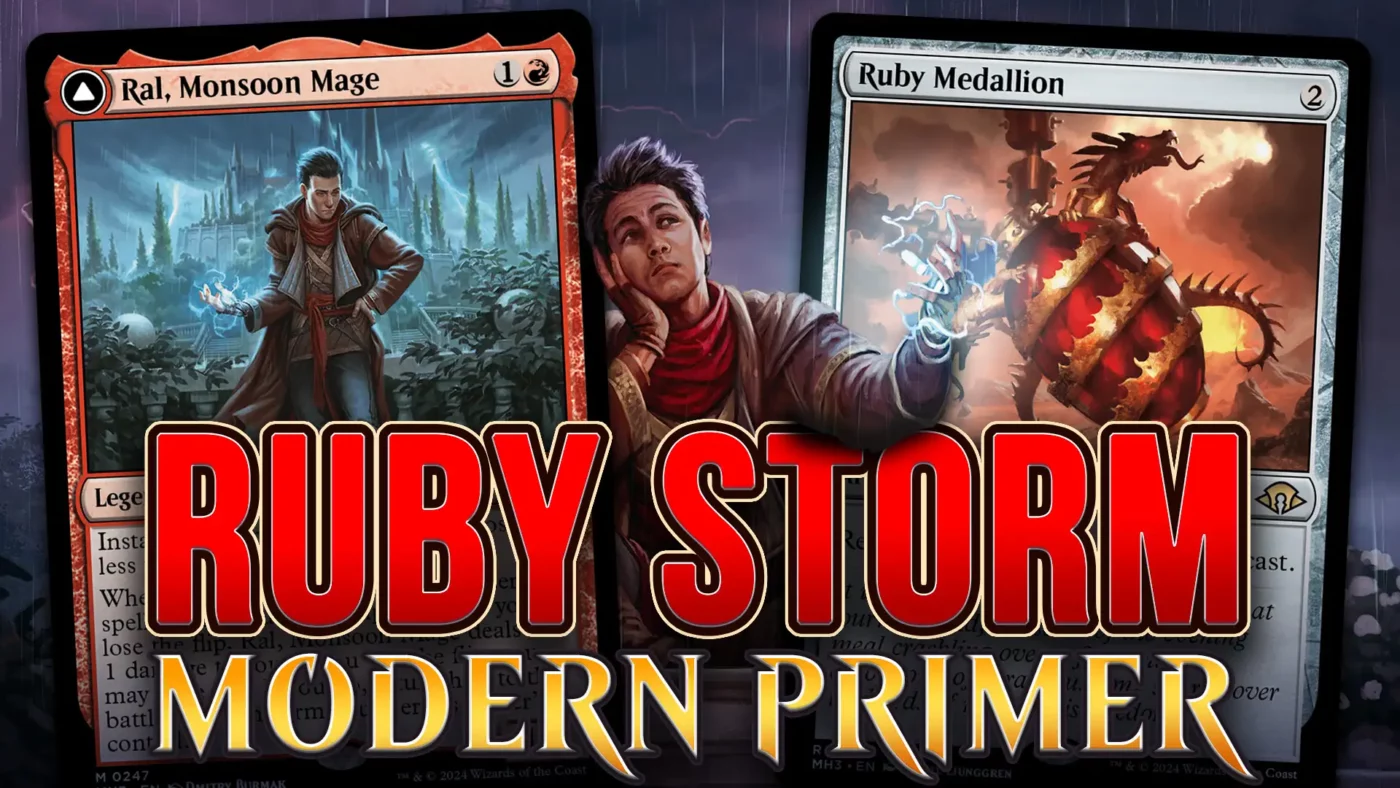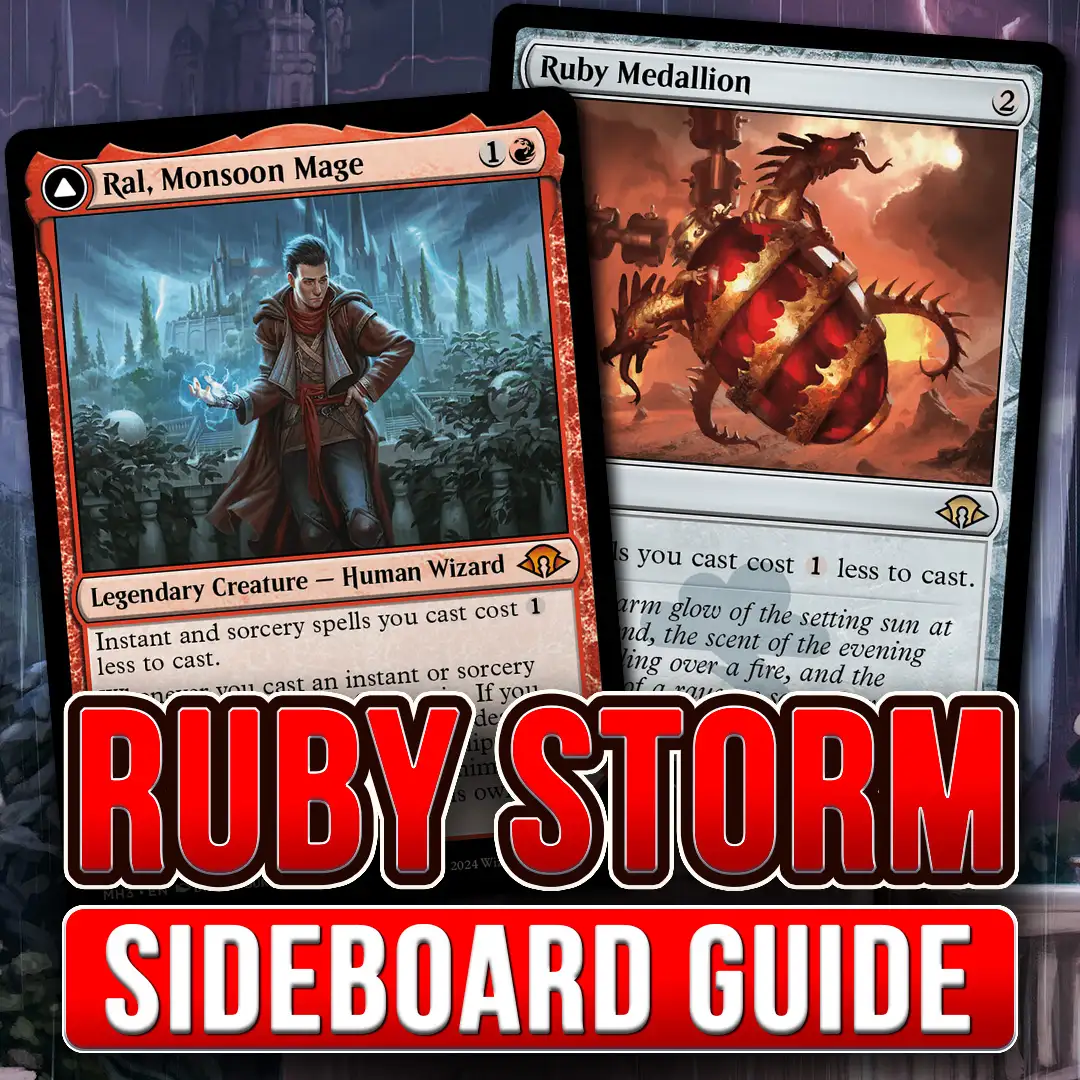With
Modern Horizons 3, Wizards of the Coast set out to revitalize combo in Modern. When people talk about the heyday of Modern in 2017-2018, Izzet Gifts Storm was the premier spell-based combo deck. Since then, the printings of [[Force of Negation]] and other interactive spells have pushed it out of the metagame.
Modern Horizons 3 adds two new cards to Modern to revitalize
Storm combo: [[Ruby Medallion]] and [[Ral, Monsoon Mage]]. Ruby Storm was considered a strong enough deck to have the second-highest metagame share at Pro Tour
Modern Horizons 3. Though it had one of the worst win rates, this is largely due to a high amount of specific
Storm hate, such as [[Drannith Magistrate]], being played rather than the core of the deck losing to average cards played in the format.
Storm is BACK in Modern!
(adsbygoogle = window.adsbygoogle || []).push({});
Like Gifts Storm, Ruby Storm attempts to win the game with [[Grapeshot]] or [[Empty the Warrens]] in most games. They both use graveyard engines such as [[Past in Flames]] to rebuy a lot of spells to generate a lethal
Storm count through many of the same pieces of fast mana. That's where many of the similarities end. Instead of producing deterministic loops, Ruby Storm overwhelms the game by drawing cards and making mana until it becomes trivial to cast every card in the deck. This is a critical mass engine. Drawing cards lets the deck make mana, which enables the deck to draw more cards and then make more mana. The average game consists of three phases. First, the setup phase where the goal is to resolve a reducer
([[Ruby Medallion]] or [[Ral, Monsoon Mage]]) and filter through the deck with
Surveil Lands to amass resources to have good odds at winning the game. The second phase is the beginning of the combo turn, where the deck needs to amass a lot of mana and
Storm count while drawing cards to do things like transform [[Ral, Monsoon Mage]]. Once the deck gets off the ground during the combo turn, it basically can not be stopped and enters the third phase: actually winning the game by finding a [[Wish]].
Core Cards
Mana
[[Desperate Ritual|]]
[[Ral, Monsoon Mage|]]
[[Manamorphose|]]
Fast mana is always the core of a
Storm deck, and Modern does not have much to offer. On their own, these rituals are each plus one mana or, in the case of [[Manamorphose]] and [[Strike It Rich]], they break even. This is why the cost reducers, [[Ruby Medallion]] and [[Ral, Monsoon Mage]], are so crucial to making the deck function. Turning [[Pyretic Ritual]] into red [[Dark Ritual]] is very powerful. Notably, [[Ruby Medallion]] will reduce the cost of [[Ral, Monsoon Mage]]. In contrast, [[Ral, Monsoon Mage]] does not reduce the cost of [[Ruby Medallion]]. This can come up in some sequences where having multiple reducers matters. [[Ral, Monsoon Mage]] has a few tricks that give it extra resilience through removal spells. By casting it with an extra mana or two, a removal spell can be responded to with attempts to flip the [[Ral, Monsoon Mage]]. Then [[Ral, Leyline Prodigy]]'s +1 can be used to keep the cost reduction going. This cost reduction lasts through the opponent's turn, even if the [[Ral, Leyline Prodigy]] dies from a removal spell or the Legend rule. The extra resilience of both the cost reducers in the deck makes it more likely to untap with one, which in turn is the strength of Ruby Storm.Not wasting the limited amount of fast mana matters. Because there is no way to go from zero mana to one mana other than land drops, the combo turn has to avoid zero mana at all costs. There is not a mana threshold that reaches a directly winning engine like in Legacy. When casting draw spells, one does not have to commit all of their rituals at the start because it is easy enough to hold them until it is clear they matter. Wasting a ritual on a shorter combo that produces advantage makes it harder to fully win the game on the next turn.[[Strike It Rich]] is an odd card. It ramps turn over turn, which is normally not something that
Storm decks are incentivized to do. However, making a second or third mana for turn two is important for Ruby Storm to function. The deck does not win without a reducer in play, and both cost two mana. A turn one [[Strike It Rich]] into a turn two reducer sets up a turn three win the same way a second land does. If you already have the second land, it can set up a turn-two win, depending on the rest of your hand! During the combo turn, the extra
Storm count is nice, but the real reason [[Strike It Rich]] is powerful during the combo turn is that it is two spells for [[Ral, Monsoon Mage]] to trigger on. In the early part of the combo turn, running out of spells to cast is a problem that [[Strike It Rich]] solves cleanly.
(adsbygoogle = window.adsbygoogle || []).push({});
Draw Spells
[[Galvanic Relay|]]
[[Reckless Impulse|]]
[[Glimpse the Impossible|]]
Generating cards is the other half of the deck, and these impulse draw effects are one of the reasons Ruby Storm is so powerful. Because they can be cast off of rituals, they can keep the combo turn going, but the cards persist into the next turn, so they can be two-mana divinations a high percentage of the time. They can just be used to dig for more cards or reducers in the early turns.Most stock lists include [[Glimpse the Impossible]], which converts uncast cards into mana at the cost of cards not persisting through multiple turns. This makes the card hard to cast tactically on any turn that is not the combo turn if you are interested in actually casting the cards. The EPIC Storm team chooses to play [[Galvanic Relay]] in that spot. [[Galvanic Relay]] lets the deck short combo much more powerfully if the engine does not fully get off the ground. An extra three to six cards on the next turn is normally plenty to win the game. Any card invested into a [[Galvanic Relay]] can be recouped by [[Past in Flames]]. [[Galvanic Relay]] is also a draw spell not beaten by counterspells. Most Modern control players will not counter rituals and will attempt to get more value out of their counter spells rather than just one-for-one a ritual. Post-board, a [[Galvanic Relay]] can push through soft hate cards like [[Pithing Needle]] or graveyard hate. The card has applications in many situations across match-ups, even if it seems to have less raw combo turn potential than [[Glimpse the Impossible]].
Lands
The first two or three lands are integral to Ruby Storm operating normally. Casting a reducer is almost required to win the game. However, finding lands during the combo turn in [[Ral, Monsoon Mage]] ultimates or off all the draw twos is not good. Mitigating this tension is one of the harder parts of deck building. Ruby Storm does this in several ways. Fetch lands remove lands from the deck and slightly decrease the chances of drawing further lands. Thinning the deck to remove extra lands matters; generally, fetch lands should be used over naturally drawn lands.Surveil lands are a critical portion of the mana base. Ruby Storm does not do a lot on turn one, and having these filter options to dig for a second land, fast mana, or the missing piece of a hand matters a lot. On the draw, a one-land hand with a fetch land is keepable, assuming the spells are good. With three looks at a second land and playing 20 lands, you are 72% to find the second land on turn two, which is pretty good odds! On the play, this lowers to 60%, which is probably not quite high enough to bet the entire game on.The last piece of balancing the mana base is the MDFC lands from
Zendikar Rising. [[Shatterskull Smashing]] is a main deck removal spell that can be cast as a [[Ral, Monsoon Mage]] trigger with no targets in a pinch. Post-board, it is responsible for removing [[Drannith Magistrate]] and other hate bears. It does come at the cost of [[Jegantha, the Wellspring]], but fitting in extra removal spells is more important than access to a 5/5. [[Valakut Awakening]] comes at a higher cost in the mana base. There can only be so many tapped lands in the deck before it starts to punish being able to cast a turn-two reducer into a turn-three win. However, especially in post-board games, it converts dead cards in hand into new cards. This [[Brainstorm]]-esque effect is important to smoothing out some of the variance and ensuring the deck stays flowing.
Engines
[[Past in Flames|]]
[[Ral, Leyline Prodigy|]]
[[Wish|]]
[[Ral, Monsoon Mage]], in addition to being a reducer, is one of the core engines of the deck. By transforming [[Ral, Monsoon Mage]] after six Instants and Sorceries have been cast in the turn, he can instantly ultimate into the draw eight spells for free. This is generally good enough to win the game, so playing to transform a lethal [[Ral, Monsoon Mage]] tends to be a core game plan. There are a couple of tricks to make it more powerful. First, if you already have a [[Ruby Medallion]] in play, you do not have to cast [[Ral, Monsoon Mage]] until the Instant and Sorcery count is six. This saves life when some of the flips go wrong. [[Ral, Monsoon Mage]] triggers only count how many Instants and Sorceries have been cast once the triggers resolve. Sometimes, to increase the odds of transforming, you can hold priority and cast a few Instants in response to triggers to bring the count high enough to ultimate. This increases the odds of flipping if, for example, spells five and six are cast together before either [[Ral, Monsoon Mage]] trigger resolves because either trigger will transform the [[Ral, Monsoon Mage]]. This can also be done to take advantage of the cost reduction static ability on [[Ral, Monsoon Mage]] before he transforms. During the early phase of a combo turn, losing [[Ral, Monsoon Mage]] as a cost reducer can matter before you find the second reducer. Rarely, declining a transform trigger that could lead to a [[Ral, Monsoon Mage]] ultimate is correct to cast several more rituals to net more mana if that is a choke point in the game.The most classic
Storm engine in Modern is [[Past in Flames]]. For Ruby Storm, it is still the core engine of the deck, even if, most of the time, it does not produce a deterministic loop. In Ruby Storm, it is the best way to draw many cards to continue making mana and draw even more cards. There can be deterministic loops, such as [[Wish]] for the sideboard copy of [[Past in Flames]],
Flashback the whole graveyard, then [[Wish]] for [[Grapeshot]]. However, saving copies of [[Past in Flames]] for those lines is not worth it. They are better spent just
"drawing" the graveyard.Like Legacy Storm decks, keeping win conditions in the main deck can be a liability. Drawing them mid-combo can stifle further development and make for awkward opening hands. [[Wish]] acts more like a split card of engine, removal spell, and win condition. It allows access to cards like [[Thassa's Oracle]], which can beat corner case situations such as infinite life or Protection from Everything.
(adsbygoogle = window.adsbygoogle || []).push({});
Mulligan Decisions
Some will say that every keepable seven must have at least two lands and a reducer. This is not true. A lot of keepable hands will look like that, but it is fine to spend turn two casting a draw two, looking for the reducer to win the game on turn three. If a hand contains a decent mix of rituals and draw effects while just being able to play Magic. In general, a glut of draw spells is better to have than too many rituals. Hands that are just rituals tend to be trap hands that make a ton of mana and then go nowhere. A couple of draw spells can then convert into mana. Too many engine spells also tends to be a mulligan. Like many
Storm Decks, Ruby Storm requires a lot of cards to start going off, and you should be reluctant to mulligan hands that can play Magic even if they are not perfect.
Anatomy of a turn two
[[Arid Mesa|]] [[Mountain|]] [[Ruby Medallion|]] [[Desperate Ritual|]] [[Pyretic Ritual|]] [[Reckless Impulse|]] [[Wrenn's Resolve|]]
Speed is always a critical component of
Storm decks. Being able to win before an opponent can set up their game or find a hate piece is one of the reasons to play Ruby Storm. If you are playing [[Gemstone Caverns]], a lucky turn one is possible. The realistic fastest win is on turn two. Any turn two win must have at least two rituals and hopefully multiple draw twos. To sequence, cast a ritual,
then cast the reducer to end up with one extra floating mana. Then, the next ritual can be cast into all the draw twos to find more mana and a [[Past in Flames]]. The above hand is the ideal case for a turn two, though some cards could be replaced by a [[Manamorphose]] or take a slightly different form.This type of hand and sequencing is also the best way to beat removal on later turns. Being able to cast the reducer and win on the same turn beats Sorcery speed removal and lets you wait for the right window to go off. On turns later than turn two, the extra land drop means you do not have to cast a ritual before a reducer. The only reason to cast a ritual before the reducer outside of a turn two win attempt is with [[Ral, Monsoon Mage]]. By having two floating mana after resolving [[Ral, Monsoon Mage]], you can attempt to flip it in response to a removal spell by keeping an instant up while comboing.
Match ups
The EPIC Storm team publishes a
complete sideboard guide and updated list every month, available for purchase in the shop. I will talk about general concepts of how to play match-ups, but for an entirely up-to-date guide with the exact ins and outs, check out the
shop!Storm combo decks play on a different axis than the average Modern deck game one, meaning that pre-boarded games Ruby Storm usually is advantaged. Post board, opponents can bring in extra counterspells, graveyard hate, and specific permanent
Storm hate. Anticipating this hate is the key to winning any post-board game. Currently, there is a mix of permanent removal, interaction for counterspells
([[Silence]]), and protection from discard effects.In slow match-ups against control decks, take all the time they give. All of the impulse draw twos are the best cards in the match-up. They provide more resources than control opponents can reasonably deal with. If they try to counter every single one, they will run out of counterspells before you run out of ways to win the game or draw more cards. Going off when the opponent taps out for cards like [[The One Ring]] or other expensive permanent is a straightforward window to crush through and win with [[Thassa's Oracle]].Against aggro decks and other combo decks, what matters is attempting to win before they do too much damage and shut off [[Ral, Monsoon Mage]]. While [[Ral, Monsoon Mage]] is not required to win the game, he makes it easier. Most aggro decks keep in some number of their removal spells. Casting a cost reducer on turn three and then trying to win the game, especially if the opponent has tapped out for a threat, is the game plan. If they keep holding up a removal spell for a reducer, they are not spending that mana on a threat. It should be obvious from the opponent's play pattern if this is their plan. Otherwise, they will tap out every turn to add more pressure to get you to go off before you're ready.

(adsbygoogle = window.adsbygoogle || []).push({});
Keep on Storming in Modern!
I am excited to play a lot more Ruby Storm. The deck is powerful despite results at the pro tour. For the average RCQ this season, it will be a good choice. There is constant talk in the
Storm Discord for development about the deck. If you have any further questions, reach out in Discord or on
Twitter. If you want to support this content, get access to sideboard guides, and early access to all of The EPIC Storm content, check out The EPIC Storm
Patreon and support us there.











